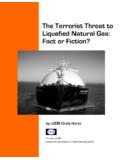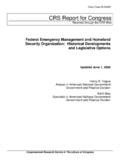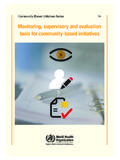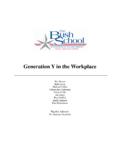Transcription of CRS Report for Congress - IAGS
1 congressional research Service The Library of CongressCRS Report for CongressReceived through the CRS WebOrder Code RL32205 Liquefied Natural Gas (LNG)Import Terminals:Siting, Safety and RegulationJanuary 28, 2004 Paul W. ParfomakSpecialist in Science and TechnologyResources, Science, and Industry DivisionAaron M. FlynnLegislative AttorneyAmerican Law DivisionLiquefied Natural Gas (LNG) Import Terminals:Siting, Safety and RegulationSummaryLiquefied natural gas (LNG) is a hazardous fuel frequently shipped in largetankers to ports from overseas. While LNG has historically made up a smallpart of natural gas supplies, rising gas prices, current price volatility, and thepossibility of domestic shortages are sharply increasing LNG demand.
2 To meet thisdemand, energy companies have proposed building dozens of new LNG importterminals throughout the coastal United States. But many of these terminals wouldbe built onshore near populated areas, so local communities fear the terminals wouldexpose them to unacceptable safety and security hazards. Potentially catastrophicpool fires or vapor cloud fires could arise from a serious accident or attack on LNGinfrastructure. Faced with the widely perceived need for greater LNG imports, andpersistent public concerns about LNG safety, Congress is examining the adequacyof safety provisions in federal LNG siting Federal Energy Regulatory Commission (FERC) grants federal approval forthe siting of new onshore LNG facilities under the Natural Gas Act of 1938.
3 Thisapproval process incorporates minimum safety standards for LNG established by theDepartment of Transportation, which, in turn, incorporate siting standards set by theNational Fire Protection Association (NFPA). Although LNG has had a record ofrelative safety for the last 40 years, and no LNG tanker or land-based facility hasbeen attacked by terrorists, experts have questioned the adequacy of key LNG sitingregulations related to safety zones, marine hazards, hazard modeling, and remotesiting. Experts have also questioned the validity of LNG hazard studies used byfederal regulatory agencies which suggest that LNG terminal risks, while significant,are not as serious as is popularly may not see a compelling need to change current federal LNG sitingrequirements if it views the current regulations and processes as sufficient.
4 Holdersof this view would continue to rely on the judgment of LNG experts in federalagencies and standards committees to appropriately balance local public safety withnational energy needs. While there have been some concerns about specificregulatory provisions, Congress may believe that the responsible governmentagencies are actively and cooperatively addressing these concerns. On the otherhand, Congress may conclude that some aspects of new LNG terminals do poseexcessive public risks, or that there is still too much uncertainty about key risks tomake final conclusions about public safety.
5 In this case, Congress has severaloptions to further address LNG terminal safety concerns. These options include 1)banning onshore LNG terminals, 2) increasing local LNG siting authority, 3)imposing more stringent federal LNG safety standards, 4) encouraging more LNGresearch, 5) curbing natural gas demand, and 6) developing alternatives tonatural gas imports. Each of these policy alternatives has significant limitations,however, and may have undesirable consequences for national energy markets andother hazardous material infrastructure. This Report will be updated as Facing Congress .
6 1 Scope and Is LNG and Where Does It Come From? ..2 Expectations for LNG Import Growth ..2 Proposed LNG Import Terminals in the United Hazards from LNG Hazards of Fires ..5 Other Safety Hazards ..5 Terrorism Hazards ..6 Safety Record of LNG ..6 Safety Regulations in Onshore LNG of Transportation ..7 Federal Energy Regulatory Commission (FERC) ..8 FERC-DOT Jurisdictional Fire Protection Association (NFPA) ..10 State Regulatory Safety Issues in LNG Terminal Exclusion Zones ..12 NFPA Perspectives ..13 FERC Safety Hazards ..14 Remote Hazard Models ..16 Hazards vs. Risks ..18 LNG Terminal Safety in Perspective.
7 19 Other Hazardous Attractiveness ..19 Civil and Criminal Options for Congress ..21 Banning Onshore LNG Terminals ..21 Increasing State Siting More Stringent More Safety research ..22 Reducing LNG ..23 Appendix: Offshore LNG Terminal Regulation ..25 List of TablesTable 1. Recently Proposed LNG 2. Recent LNG Hazard 49 List of Hazardous Materials. Office of Hazardous Materials Safety,Department of Natural Gas (LNG) Terminals:Siting, Safety and RegulationIntroductionLiquefied natural gas (LNG) has long played a role in energy markets, butconcerns about rising natural gas prices, current price volatility, and the possibilityof domestic shortages are sharply increasing demand for LNG imports.
8 To meet thisdemand, dozens of new onshore and offshore LNG import terminals have beenproposed in coastal regions throughout the United States. But LNG is a hazardous1liquid transported and stored in enormous quantities, often near populated exist about the safety hazards of new LNG import terminals and the federalgovernment s role in addressing LNG safety in the terminal siting process. Inaddition, various energy policy proposals could impact the need for new LNGterminals by encouraging the development of alternative energy supplies andpromoting Report provides an overview of recent industry proposals for new LNGimport terminals.
9 The Report summarizes LNG safety hazards and the industry ssafety record. It summarizes federal laws and regulations related to LNG terminalsiting with a focus on the authorities of key federal agencies and safety provisions inthe permitting of onshore facilities. The Report discusses controversial safety issuesin recent LNG siting proceedings, such as safety zones, marine hazards, hazardmodeling, and remote siting. The Report outlines policy options related to LNGterminal safety, including 1) banning onshore terminals, 2) increasing local authority,3) imposing more stringent standards, 4) encouraging more LNG research , 5) curbinggas demand, and 6) developing alternatives to natural gas Facing CongressProposed LNG terminals will directly impact the safety of communities in anumber of states and congressional districts, and they are likely to influence energycosts nationwide.
10 Faced with the widely perceived national need for greater LNGimports, and persistent public concerns about LNG hazards, some in Congress areexamining the adequacy of safety provisions in federal LNG siting regulation. IfCongress concludes that new LNG terminals as currently regulated will pose anunacceptable risk to public safety, Congress may consider additional LNG safety-related legislation, or may exercise its oversight authority in other ways to influenceLNG terminal siting approval. Alternatively, Congress may consider other changesin energy policy legislation to reduce the nation s demand for natural gas.











